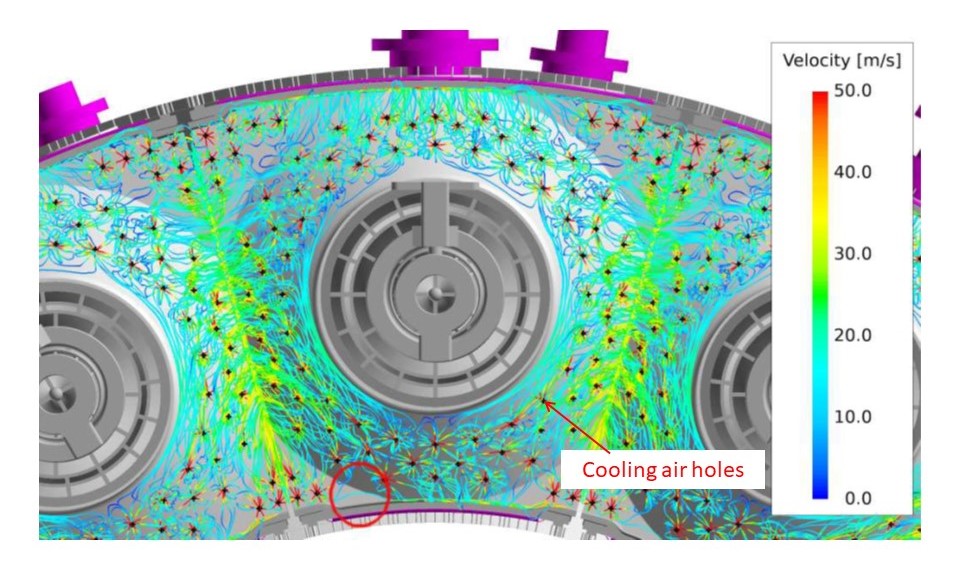Investigation of internal flow of aircraft combustor for En-Core Project.
JAXA Supercomputer System Annual Report February 2023-January 2024
Report Number: R23EA0714
Subject Category: Aeronautical Technology
- Responsible Representative: Mitsumasa Makida(JAXA, Aeronautical Technology Directorate)
- Contact Information: Mitsumasa Makida(JAXA, Aeronautical Technology Directorate)(makida.mitsumasa@jaxa.jp)
- Members: Naoki Nakamura, Mitsumasa Makida, Takashi Ishiyama
Abstract
In the development process of aircraft combustors, air mass flow distribution between fuel nozzles, dilution and cooling air holes on the liner effects performances of combustors. So it is important to understand the internal flow and estimate the mass flow distribution. In this research, we conduct cold-flow simulations of internal flow inside the combustor which faithfully simulates the configuration of practical combustor. Then we aim to develop methods to analyze aerodynamic performance of combustors such as air mass flow distribution with high accuracy.
Reference URL
N/A
Reasons and benefits of using JAXA Supercomputer System
It is important to do parametric case study with slightly different geometry, and each case needs large scale simulation. To conduct such simulation effectively, we need the super computer with high parallelization efficiency.
Achievements of the Year
In this fiscal year, we conducted cold-flow simulations for a single-sector region of combustor. These simulations aimed to estimate the effect of the flow from cooling air holes to the internal flow of the combustor. We also estimated the effect of these cooling air holes on the total air flow distribution. Fig.1 shows the total view of the combustor. Also as examples of calculation result, Fig.2 shows stream lines from cooling air holes behind the conical heat shield (colored by velocity), and Fig.3 shows stream lines from cooling air holes behind the cooling panels. To do comparison studies by allocating a number of detailed cooling air holes to the combustor, the overset boundary method, in which corresponding parts can be allocated, is effective.
Publications
N/A
Usage of JSS
Computational Information
- Process Parallelization Methods: MPI
- Thread Parallelization Methods: Automatic Parallelization
- Number of Processes: 1536
- Elapsed Time per Case: 205 Hour(s)
JSS3 Resources Used
Fraction of Usage in Total Resources*1(%): 0.16
Details
Please refer to System Configuration of JSS3 for the system configuration and major specifications of JSS3.
| System Name | CPU Resources Used(Core x Hours) | Fraction of Usage*2(%) |
|---|---|---|
| TOKI-SORA | 3811316.60 | 0.17 |
| TOKI-ST | 99309.14 | 0.11 |
| TOKI-GP | 0.00 | 0.00 |
| TOKI-XM | 0.00 | 0.00 |
| TOKI-LM | 2964.98 | 0.23 |
| TOKI-TST | 0.00 | 0.00 |
| TOKI-TGP | 0.00 | 0.00 |
| TOKI-TLM | 0.00 | 0.00 |
| File System Name | Storage Assigned(GiB) | Fraction of Usage*2(%) |
|---|---|---|
| /home | 69.15 | 0.06 |
| /data and /data2 | 8762.50 | 0.05 |
| /ssd | 0.00 | 0.00 |
| Archiver Name | Storage Used(TiB) | Fraction of Usage*2(%) |
|---|---|---|
| J-SPACE | 3.98 | 0.01 |
*1: Fraction of Usage in Total Resources: Weighted average of three resource types (Computing, File System, and Archiver).
*2: Fraction of Usage:Percentage of usage relative to each resource used in one year.
ISV Software Licenses Used
| ISV Software Licenses Used(Hours) | Fraction of Usage*2(%) | |
|---|---|---|
| ISV Software Licenses(Total) | 581.56 | 0.26 |
*2: Fraction of Usage:Percentage of usage relative to each resource used in one year.
JAXA Supercomputer System Annual Report February 2023-January 2024





